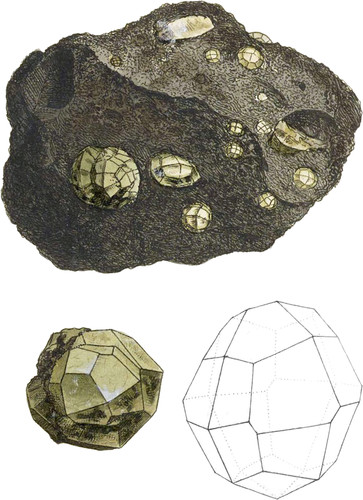 Enlarge
Enlarge
Exotic Mineralogy
Amphigene
- Syn.
- Amphigéne. Haüy, 2. 362, Tabl. 33.
- Leuzit. Werner.
- Leucit. Emmerl. 1. 53.
- Grenats blancs. Sciagr. 2. 276.
- Vesuvian, or white garnet of Vesuvius. Kirw. 1. 285.
The crystallized form of this substance has formerly been a cause of much confusion, from its resemblance to Analcime, B. M. tab. 69, and must not be confounded with the white garnet, B. M. tab. 120. Amphigéne has with some propriety been called Vesuvian, to distinguish it from Analcime, which outwardly resembles it, in figure especially, and is found in rocks that are not understood to be volcanic. It is so abundant in the neighbourliood of the crater of Vesuvius, that many of the lava cinders are full of crystals of it. This lava has apparently undergone a strong heat, but the constituent parts of the Amphigene were such as to endure it without much alteration; sometimes, however, they are full of flaws, as if caused by sudden cooling. This might at first sight give an idea of the Analcime in its matrix being changed by heat, but Analcime will not endure so much heat without obliterating its crystallized form. The crystals, as represented, have twenty-four trapezoidal faces, somewhat irregular; they are often smaller than a mustard seed, and the largest I know of is the size of the outline at the bottom, of which I have a model, (by favor of the friendly Dr. Fetton) or rather a most accurate cast. It is in the Thompsonian collection, now in the museum at Edinburgh College. The integrant molecule, according to Haüy, is a tetraëdron, the primitive a cube, its fracture flattish in the direction of the cube, and mostly conchoidal (otherwise generally rather full of flaws of both sorts), mostly semitransparent, nearly as hard as Quartz, scratches glass, Spec. Grav. according to different authors, from 2.455 to 2.490. It is often found in a decomposing state, when it is opaque, and nearly pulverulent.
| Analysis by Klaproth. | By Vauquelin. | |
|---|---|---|
| Silica | 54 | 56 |
| Alumine | 24 | 20 |
| Potash | 21 | 20 |
| Lime | 0 | 2 |
| Loss | 1 | 2 |
| 100 | 100 | |

